Assessment Task 3: Leadership and Value Creation Report
VerifiedAdded on 2023/01/11
|7
|2953
|82
Report
AI Summary
This report examines the impact of digitalization on business models and value creation, with a focus on the jewelry industry. It explores the fundamentals of digital markets, strategic business challenges, and the importance of agile leadership in adapting to change. The report analyzes the linkages be...
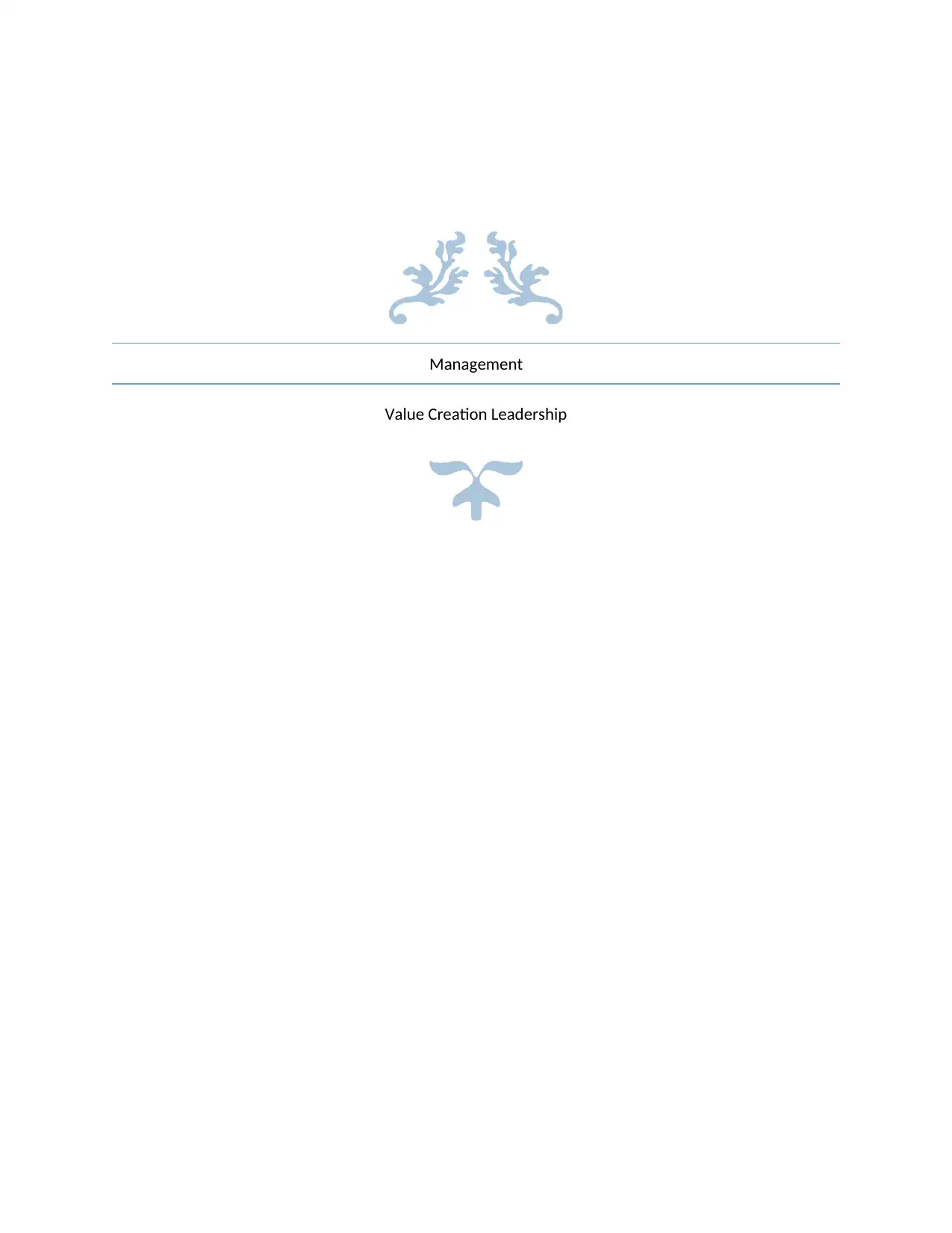
Management
Value Creation Leadership
Value Creation Leadership
Paraphrase This Document
Need a fresh take? Get an instant paraphrase of this document with our AI Paraphraser
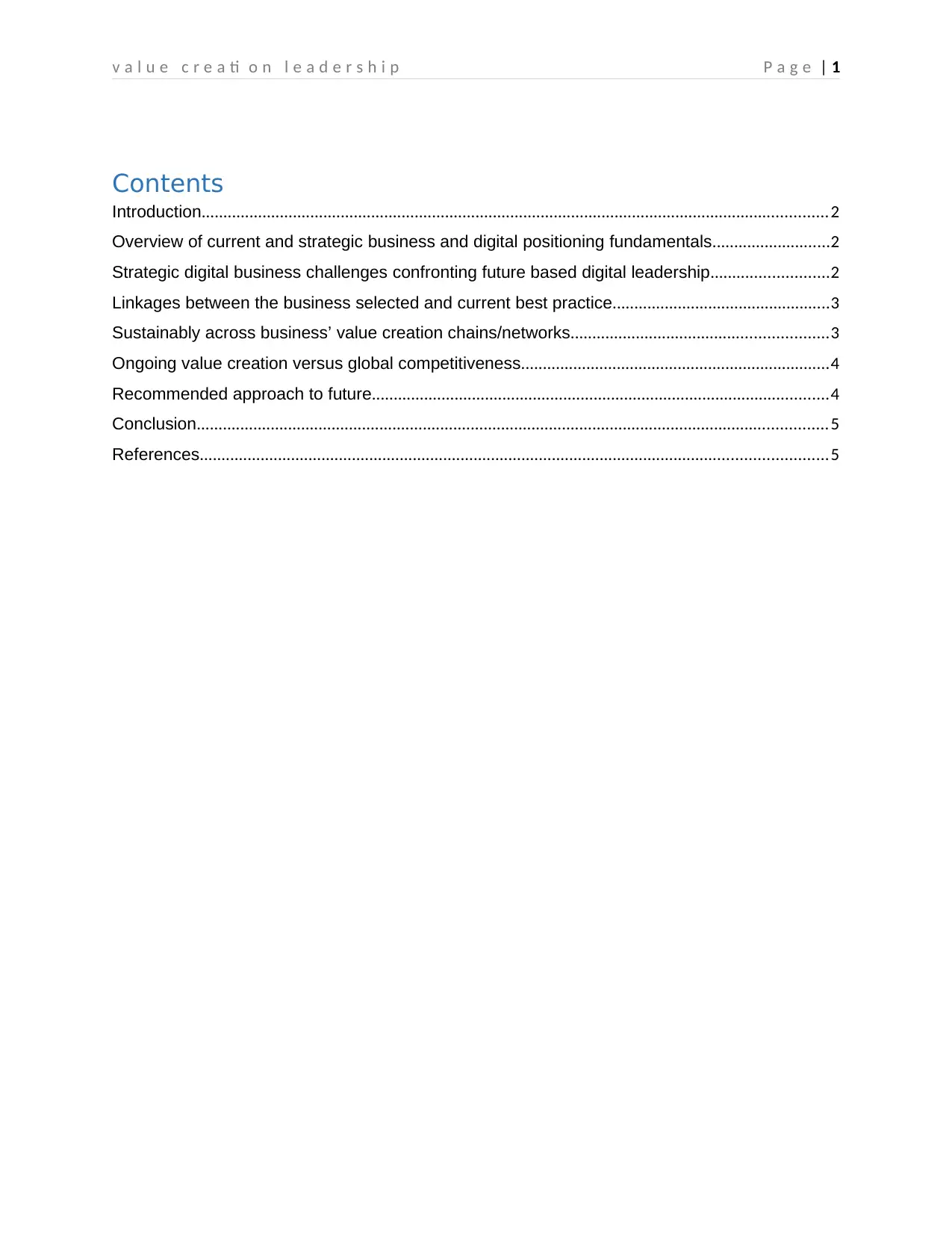
v a l u e c r e a ti o n l e a d e r s h i p P a g e | 1
Contents
Introduction................................................................................................................................................2
Overview of current and strategic business and digital positioning fundamentals...........................2
Strategic digital business challenges confronting future based digital leadership...........................2
Linkages between the business selected and current best practice..................................................3
Sustainably across business’ value creation chains/networks...........................................................3
Ongoing value creation versus global competitiveness.......................................................................4
Recommended approach to future.........................................................................................................4
Conclusion.................................................................................................................................................5
References................................................................................................................................................5
Contents
Introduction................................................................................................................................................2
Overview of current and strategic business and digital positioning fundamentals...........................2
Strategic digital business challenges confronting future based digital leadership...........................2
Linkages between the business selected and current best practice..................................................3
Sustainably across business’ value creation chains/networks...........................................................3
Ongoing value creation versus global competitiveness.......................................................................4
Recommended approach to future.........................................................................................................4
Conclusion.................................................................................................................................................5
References................................................................................................................................................5
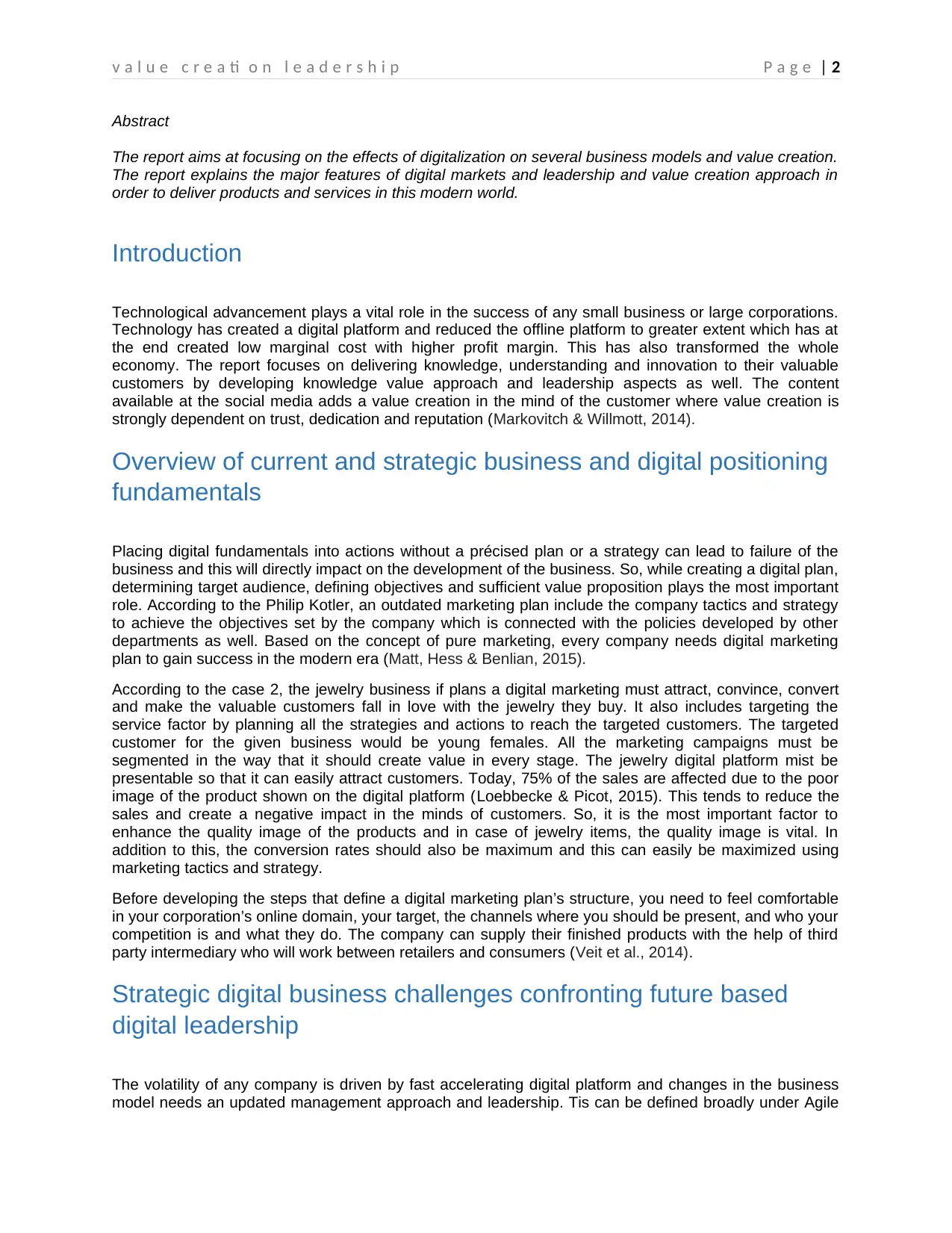
v a l u e c r e a ti o n l e a d e r s h i p P a g e | 2
Abstract
The report aims at focusing on the effects of digitalization on several business models and value creation.
The report explains the major features of digital markets and leadership and value creation approach in
order to deliver products and services in this modern world.
Introduction
Technological advancement plays a vital role in the success of any small business or large corporations.
Technology has created a digital platform and reduced the offline platform to greater extent which has at
the end created low marginal cost with higher profit margin. This has also transformed the whole
economy. The report focuses on delivering knowledge, understanding and innovation to their valuable
customers by developing knowledge value approach and leadership aspects as well. The content
available at the social media adds a value creation in the mind of the customer where value creation is
strongly dependent on trust, dedication and reputation (Markovitch & Willmott, 2014).
Overview of current and strategic business and digital positioning
fundamentals
Placing digital fundamentals into actions without a précised plan or a strategy can lead to failure of the
business and this will directly impact on the development of the business. So, while creating a digital plan,
determining target audience, defining objectives and sufficient value proposition plays the most important
role. According to the Philip Kotler, an outdated marketing plan include the company tactics and strategy
to achieve the objectives set by the company which is connected with the policies developed by other
departments as well. Based on the concept of pure marketing, every company needs digital marketing
plan to gain success in the modern era (Matt, Hess & Benlian, 2015).
According to the case 2, the jewelry business if plans a digital marketing must attract, convince, convert
and make the valuable customers fall in love with the jewelry they buy. It also includes targeting the
service factor by planning all the strategies and actions to reach the targeted customers. The targeted
customer for the given business would be young females. All the marketing campaigns must be
segmented in the way that it should create value in every stage. The jewelry digital platform mist be
presentable so that it can easily attract customers. Today, 75% of the sales are affected due to the poor
image of the product shown on the digital platform (Loebbecke & Picot, 2015). This tends to reduce the
sales and create a negative impact in the minds of customers. So, it is the most important factor to
enhance the quality image of the products and in case of jewelry items, the quality image is vital. In
addition to this, the conversion rates should also be maximum and this can easily be maximized using
marketing tactics and strategy.
Before developing the steps that define a digital marketing plan’s structure, you need to feel comfortable
in your corporation’s online domain, your target, the channels where you should be present, and who your
competition is and what they do. The company can supply their finished products with the help of third
party intermediary who will work between retailers and consumers (Veit et al., 2014).
Strategic digital business challenges confronting future based
digital leadership
The volatility of any company is driven by fast accelerating digital platform and changes in the business
model needs an updated management approach and leadership. Tis can be defined broadly under Agile
Abstract
The report aims at focusing on the effects of digitalization on several business models and value creation.
The report explains the major features of digital markets and leadership and value creation approach in
order to deliver products and services in this modern world.
Introduction
Technological advancement plays a vital role in the success of any small business or large corporations.
Technology has created a digital platform and reduced the offline platform to greater extent which has at
the end created low marginal cost with higher profit margin. This has also transformed the whole
economy. The report focuses on delivering knowledge, understanding and innovation to their valuable
customers by developing knowledge value approach and leadership aspects as well. The content
available at the social media adds a value creation in the mind of the customer where value creation is
strongly dependent on trust, dedication and reputation (Markovitch & Willmott, 2014).
Overview of current and strategic business and digital positioning
fundamentals
Placing digital fundamentals into actions without a précised plan or a strategy can lead to failure of the
business and this will directly impact on the development of the business. So, while creating a digital plan,
determining target audience, defining objectives and sufficient value proposition plays the most important
role. According to the Philip Kotler, an outdated marketing plan include the company tactics and strategy
to achieve the objectives set by the company which is connected with the policies developed by other
departments as well. Based on the concept of pure marketing, every company needs digital marketing
plan to gain success in the modern era (Matt, Hess & Benlian, 2015).
According to the case 2, the jewelry business if plans a digital marketing must attract, convince, convert
and make the valuable customers fall in love with the jewelry they buy. It also includes targeting the
service factor by planning all the strategies and actions to reach the targeted customers. The targeted
customer for the given business would be young females. All the marketing campaigns must be
segmented in the way that it should create value in every stage. The jewelry digital platform mist be
presentable so that it can easily attract customers. Today, 75% of the sales are affected due to the poor
image of the product shown on the digital platform (Loebbecke & Picot, 2015). This tends to reduce the
sales and create a negative impact in the minds of customers. So, it is the most important factor to
enhance the quality image of the products and in case of jewelry items, the quality image is vital. In
addition to this, the conversion rates should also be maximum and this can easily be maximized using
marketing tactics and strategy.
Before developing the steps that define a digital marketing plan’s structure, you need to feel comfortable
in your corporation’s online domain, your target, the channels where you should be present, and who your
competition is and what they do. The company can supply their finished products with the help of third
party intermediary who will work between retailers and consumers (Veit et al., 2014).
Strategic digital business challenges confronting future based
digital leadership
The volatility of any company is driven by fast accelerating digital platform and changes in the business
model needs an updated management approach and leadership. Tis can be defined broadly under Agile
⊘ This is a preview!⊘
Do you want full access?
Subscribe today to unlock all pages.

Trusted by 1+ million students worldwide
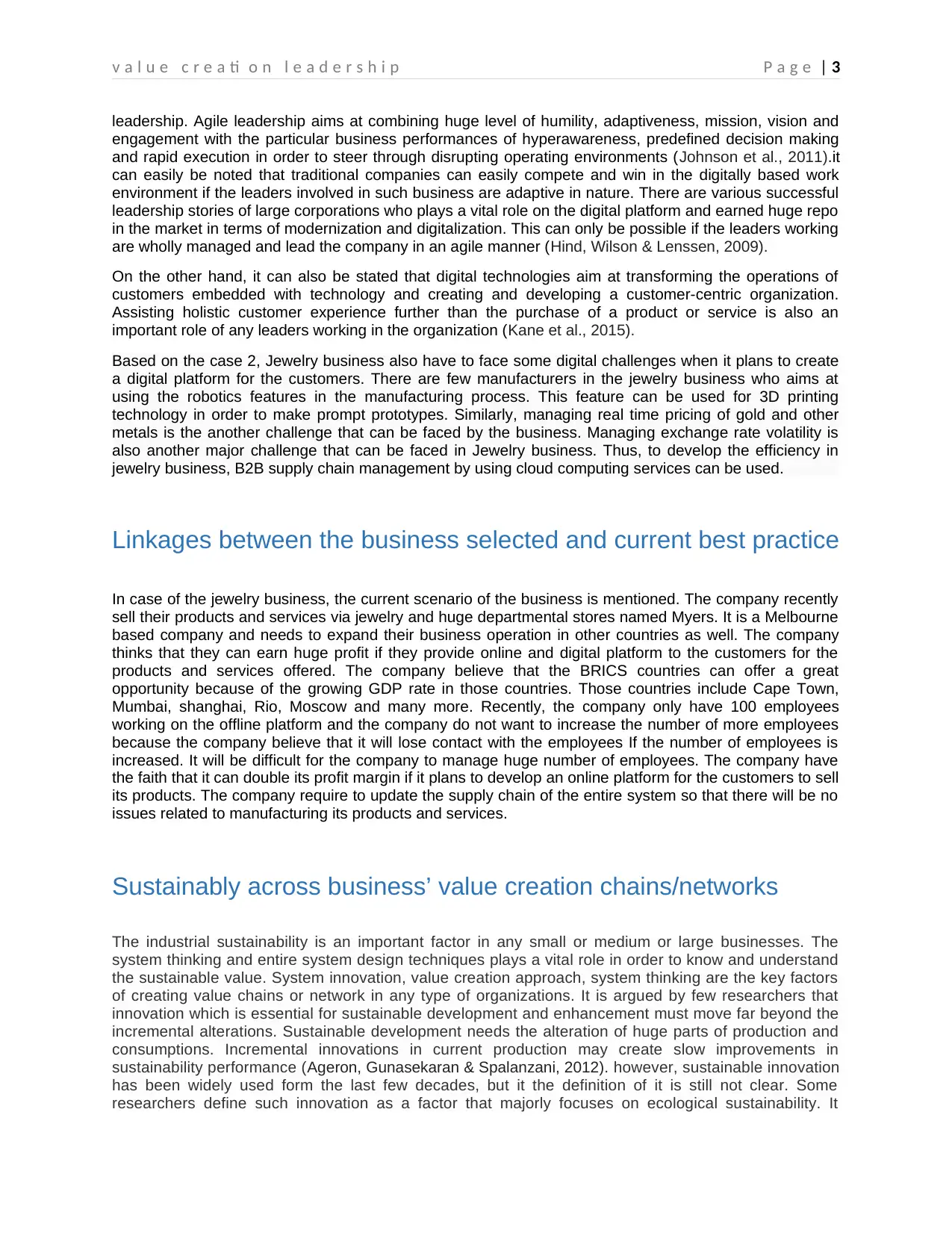
v a l u e c r e a ti o n l e a d e r s h i p P a g e | 3
leadership. Agile leadership aims at combining huge level of humility, adaptiveness, mission, vision and
engagement with the particular business performances of hyperawareness, predefined decision making
and rapid execution in order to steer through disrupting operating environments (Johnson et al., 2011).it
can easily be noted that traditional companies can easily compete and win in the digitally based work
environment if the leaders involved in such business are adaptive in nature. There are various successful
leadership stories of large corporations who plays a vital role on the digital platform and earned huge repo
in the market in terms of modernization and digitalization. This can only be possible if the leaders working
are wholly managed and lead the company in an agile manner (Hind, Wilson & Lenssen, 2009).
On the other hand, it can also be stated that digital technologies aim at transforming the operations of
customers embedded with technology and creating and developing a customer-centric organization.
Assisting holistic customer experience further than the purchase of a product or service is also an
important role of any leaders working in the organization (Kane et al., 2015).
Based on the case 2, Jewelry business also have to face some digital challenges when it plans to create
a digital platform for the customers. There are few manufacturers in the jewelry business who aims at
using the robotics features in the manufacturing process. This feature can be used for 3D printing
technology in order to make prompt prototypes. Similarly, managing real time pricing of gold and other
metals is the another challenge that can be faced by the business. Managing exchange rate volatility is
also another major challenge that can be faced in Jewelry business. Thus, to develop the efficiency in
jewelry business, B2B supply chain management by using cloud computing services can be used.
Linkages between the business selected and current best practice
In case of the jewelry business, the current scenario of the business is mentioned. The company recently
sell their products and services via jewelry and huge departmental stores named Myers. It is a Melbourne
based company and needs to expand their business operation in other countries as well. The company
thinks that they can earn huge profit if they provide online and digital platform to the customers for the
products and services offered. The company believe that the BRICS countries can offer a great
opportunity because of the growing GDP rate in those countries. Those countries include Cape Town,
Mumbai, shanghai, Rio, Moscow and many more. Recently, the company only have 100 employees
working on the offline platform and the company do not want to increase the number of more employees
because the company believe that it will lose contact with the employees If the number of employees is
increased. It will be difficult for the company to manage huge number of employees. The company have
the faith that it can double its profit margin if it plans to develop an online platform for the customers to sell
its products. The company require to update the supply chain of the entire system so that there will be no
issues related to manufacturing its products and services.
Sustainably across business’ value creation chains/networks
The industrial sustainability is an important factor in any small or medium or large businesses. The
system thinking and entire system design techniques plays a vital role in order to know and understand
the sustainable value. System innovation, value creation approach, system thinking are the key factors
of creating value chains or network in any type of organizations. It is argued by few researchers that
innovation which is essential for sustainable development and enhancement must move far beyond the
incremental alterations. Sustainable development needs the alteration of huge parts of production and
consumptions. Incremental innovations in current production may create slow improvements in
sustainability performance (Ageron, Gunasekaran & Spalanzani, 2012). however, sustainable innovation
has been widely used form the last few decades, but it the definition of it is still not clear. Some
researchers define such innovation as a factor that majorly focuses on ecological sustainability. It
leadership. Agile leadership aims at combining huge level of humility, adaptiveness, mission, vision and
engagement with the particular business performances of hyperawareness, predefined decision making
and rapid execution in order to steer through disrupting operating environments (Johnson et al., 2011).it
can easily be noted that traditional companies can easily compete and win in the digitally based work
environment if the leaders involved in such business are adaptive in nature. There are various successful
leadership stories of large corporations who plays a vital role on the digital platform and earned huge repo
in the market in terms of modernization and digitalization. This can only be possible if the leaders working
are wholly managed and lead the company in an agile manner (Hind, Wilson & Lenssen, 2009).
On the other hand, it can also be stated that digital technologies aim at transforming the operations of
customers embedded with technology and creating and developing a customer-centric organization.
Assisting holistic customer experience further than the purchase of a product or service is also an
important role of any leaders working in the organization (Kane et al., 2015).
Based on the case 2, Jewelry business also have to face some digital challenges when it plans to create
a digital platform for the customers. There are few manufacturers in the jewelry business who aims at
using the robotics features in the manufacturing process. This feature can be used for 3D printing
technology in order to make prompt prototypes. Similarly, managing real time pricing of gold and other
metals is the another challenge that can be faced by the business. Managing exchange rate volatility is
also another major challenge that can be faced in Jewelry business. Thus, to develop the efficiency in
jewelry business, B2B supply chain management by using cloud computing services can be used.
Linkages between the business selected and current best practice
In case of the jewelry business, the current scenario of the business is mentioned. The company recently
sell their products and services via jewelry and huge departmental stores named Myers. It is a Melbourne
based company and needs to expand their business operation in other countries as well. The company
thinks that they can earn huge profit if they provide online and digital platform to the customers for the
products and services offered. The company believe that the BRICS countries can offer a great
opportunity because of the growing GDP rate in those countries. Those countries include Cape Town,
Mumbai, shanghai, Rio, Moscow and many more. Recently, the company only have 100 employees
working on the offline platform and the company do not want to increase the number of more employees
because the company believe that it will lose contact with the employees If the number of employees is
increased. It will be difficult for the company to manage huge number of employees. The company have
the faith that it can double its profit margin if it plans to develop an online platform for the customers to sell
its products. The company require to update the supply chain of the entire system so that there will be no
issues related to manufacturing its products and services.
Sustainably across business’ value creation chains/networks
The industrial sustainability is an important factor in any small or medium or large businesses. The
system thinking and entire system design techniques plays a vital role in order to know and understand
the sustainable value. System innovation, value creation approach, system thinking are the key factors
of creating value chains or network in any type of organizations. It is argued by few researchers that
innovation which is essential for sustainable development and enhancement must move far beyond the
incremental alterations. Sustainable development needs the alteration of huge parts of production and
consumptions. Incremental innovations in current production may create slow improvements in
sustainability performance (Ageron, Gunasekaran & Spalanzani, 2012). however, sustainable innovation
has been widely used form the last few decades, but it the definition of it is still not clear. Some
researchers define such innovation as a factor that majorly focuses on ecological sustainability. It
Paraphrase This Document
Need a fresh take? Get an instant paraphrase of this document with our AI Paraphraser
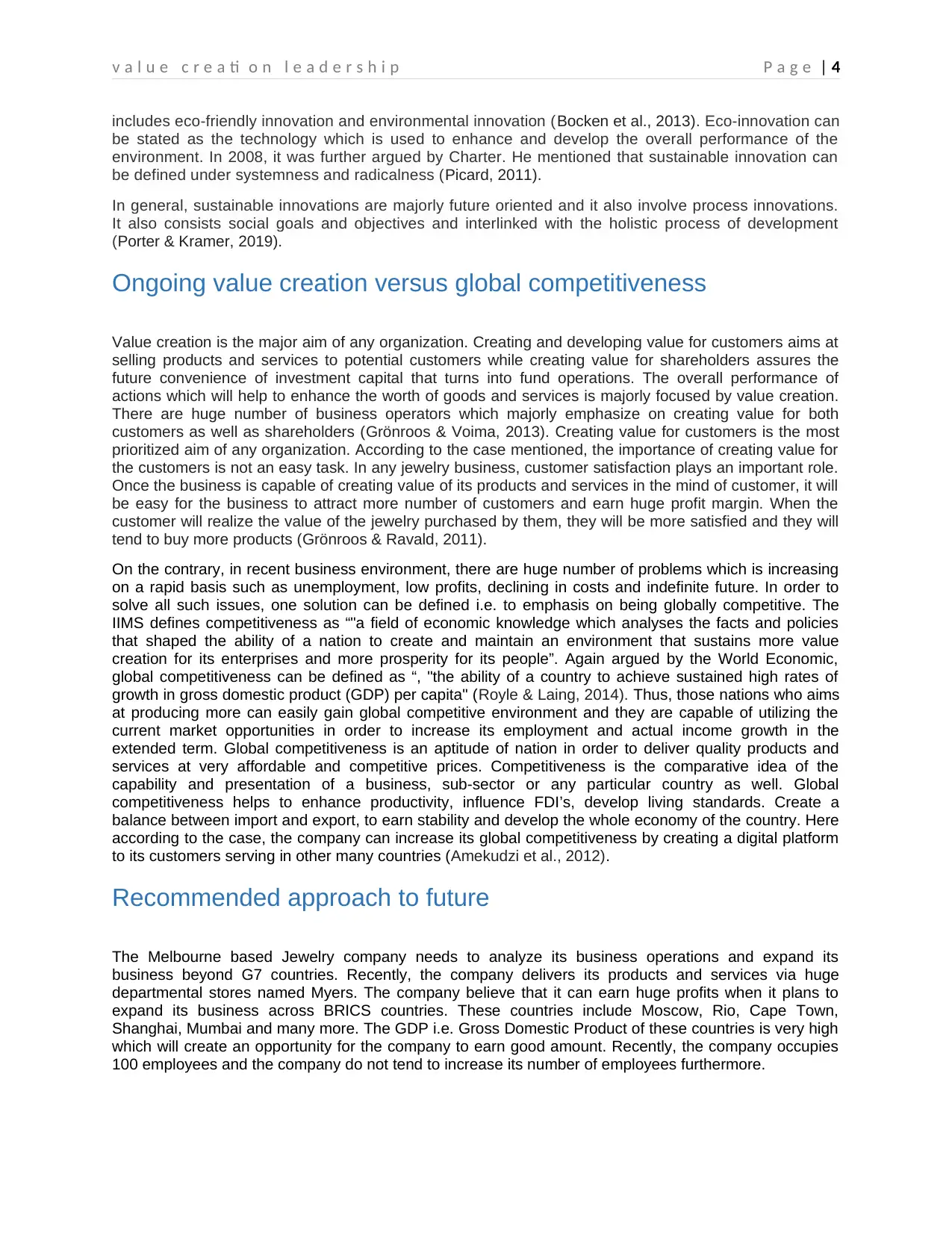
v a l u e c r e a ti o n l e a d e r s h i p P a g e | 4
includes eco-friendly innovation and environmental innovation (Bocken et al., 2013). Eco-innovation can
be stated as the technology which is used to enhance and develop the overall performance of the
environment. In 2008, it was further argued by Charter. He mentioned that sustainable innovation can
be defined under systemness and radicalness (Picard, 2011).
In general, sustainable innovations are majorly future oriented and it also involve process innovations.
It also consists social goals and objectives and interlinked with the holistic process of development
(Porter & Kramer, 2019).
Ongoing value creation versus global competitiveness
Value creation is the major aim of any organization. Creating and developing value for customers aims at
selling products and services to potential customers while creating value for shareholders assures the
future convenience of investment capital that turns into fund operations. The overall performance of
actions which will help to enhance the worth of goods and services is majorly focused by value creation.
There are huge number of business operators which majorly emphasize on creating value for both
customers as well as shareholders (Grönroos & Voima, 2013). Creating value for customers is the most
prioritized aim of any organization. According to the case mentioned, the importance of creating value for
the customers is not an easy task. In any jewelry business, customer satisfaction plays an important role.
Once the business is capable of creating value of its products and services in the mind of customer, it will
be easy for the business to attract more number of customers and earn huge profit margin. When the
customer will realize the value of the jewelry purchased by them, they will be more satisfied and they will
tend to buy more products (Grönroos & Ravald, 2011).
On the contrary, in recent business environment, there are huge number of problems which is increasing
on a rapid basis such as unemployment, low profits, declining in costs and indefinite future. In order to
solve all such issues, one solution can be defined i.e. to emphasis on being globally competitive. The
IIMS defines competitiveness as “"a field of economic knowledge which analyses the facts and policies
that shaped the ability of a nation to create and maintain an environment that sustains more value
creation for its enterprises and more prosperity for its people”. Again argued by the World Economic,
global competitiveness can be defined as “, "the ability of a country to achieve sustained high rates of
growth in gross domestic product (GDP) per capita" (Royle & Laing, 2014). Thus, those nations who aims
at producing more can easily gain global competitive environment and they are capable of utilizing the
current market opportunities in order to increase its employment and actual income growth in the
extended term. Global competitiveness is an aptitude of nation in order to deliver quality products and
services at very affordable and competitive prices. Competitiveness is the comparative idea of the
capability and presentation of a business, sub-sector or any particular country as well. Global
competitiveness helps to enhance productivity, influence FDI’s, develop living standards. Create a
balance between import and export, to earn stability and develop the whole economy of the country. Here
according to the case, the company can increase its global competitiveness by creating a digital platform
to its customers serving in other many countries (Amekudzi et al., 2012).
Recommended approach to future
The Melbourne based Jewelry company needs to analyze its business operations and expand its
business beyond G7 countries. Recently, the company delivers its products and services via huge
departmental stores named Myers. The company believe that it can earn huge profits when it plans to
expand its business across BRICS countries. These countries include Moscow, Rio, Cape Town,
Shanghai, Mumbai and many more. The GDP i.e. Gross Domestic Product of these countries is very high
which will create an opportunity for the company to earn good amount. Recently, the company occupies
100 employees and the company do not tend to increase its number of employees furthermore.
includes eco-friendly innovation and environmental innovation (Bocken et al., 2013). Eco-innovation can
be stated as the technology which is used to enhance and develop the overall performance of the
environment. In 2008, it was further argued by Charter. He mentioned that sustainable innovation can
be defined under systemness and radicalness (Picard, 2011).
In general, sustainable innovations are majorly future oriented and it also involve process innovations.
It also consists social goals and objectives and interlinked with the holistic process of development
(Porter & Kramer, 2019).
Ongoing value creation versus global competitiveness
Value creation is the major aim of any organization. Creating and developing value for customers aims at
selling products and services to potential customers while creating value for shareholders assures the
future convenience of investment capital that turns into fund operations. The overall performance of
actions which will help to enhance the worth of goods and services is majorly focused by value creation.
There are huge number of business operators which majorly emphasize on creating value for both
customers as well as shareholders (Grönroos & Voima, 2013). Creating value for customers is the most
prioritized aim of any organization. According to the case mentioned, the importance of creating value for
the customers is not an easy task. In any jewelry business, customer satisfaction plays an important role.
Once the business is capable of creating value of its products and services in the mind of customer, it will
be easy for the business to attract more number of customers and earn huge profit margin. When the
customer will realize the value of the jewelry purchased by them, they will be more satisfied and they will
tend to buy more products (Grönroos & Ravald, 2011).
On the contrary, in recent business environment, there are huge number of problems which is increasing
on a rapid basis such as unemployment, low profits, declining in costs and indefinite future. In order to
solve all such issues, one solution can be defined i.e. to emphasis on being globally competitive. The
IIMS defines competitiveness as “"a field of economic knowledge which analyses the facts and policies
that shaped the ability of a nation to create and maintain an environment that sustains more value
creation for its enterprises and more prosperity for its people”. Again argued by the World Economic,
global competitiveness can be defined as “, "the ability of a country to achieve sustained high rates of
growth in gross domestic product (GDP) per capita" (Royle & Laing, 2014). Thus, those nations who aims
at producing more can easily gain global competitive environment and they are capable of utilizing the
current market opportunities in order to increase its employment and actual income growth in the
extended term. Global competitiveness is an aptitude of nation in order to deliver quality products and
services at very affordable and competitive prices. Competitiveness is the comparative idea of the
capability and presentation of a business, sub-sector or any particular country as well. Global
competitiveness helps to enhance productivity, influence FDI’s, develop living standards. Create a
balance between import and export, to earn stability and develop the whole economy of the country. Here
according to the case, the company can increase its global competitiveness by creating a digital platform
to its customers serving in other many countries (Amekudzi et al., 2012).
Recommended approach to future
The Melbourne based Jewelry company needs to analyze its business operations and expand its
business beyond G7 countries. Recently, the company delivers its products and services via huge
departmental stores named Myers. The company believe that it can earn huge profits when it plans to
expand its business across BRICS countries. These countries include Moscow, Rio, Cape Town,
Shanghai, Mumbai and many more. The GDP i.e. Gross Domestic Product of these countries is very high
which will create an opportunity for the company to earn good amount. Recently, the company occupies
100 employees and the company do not tend to increase its number of employees furthermore.
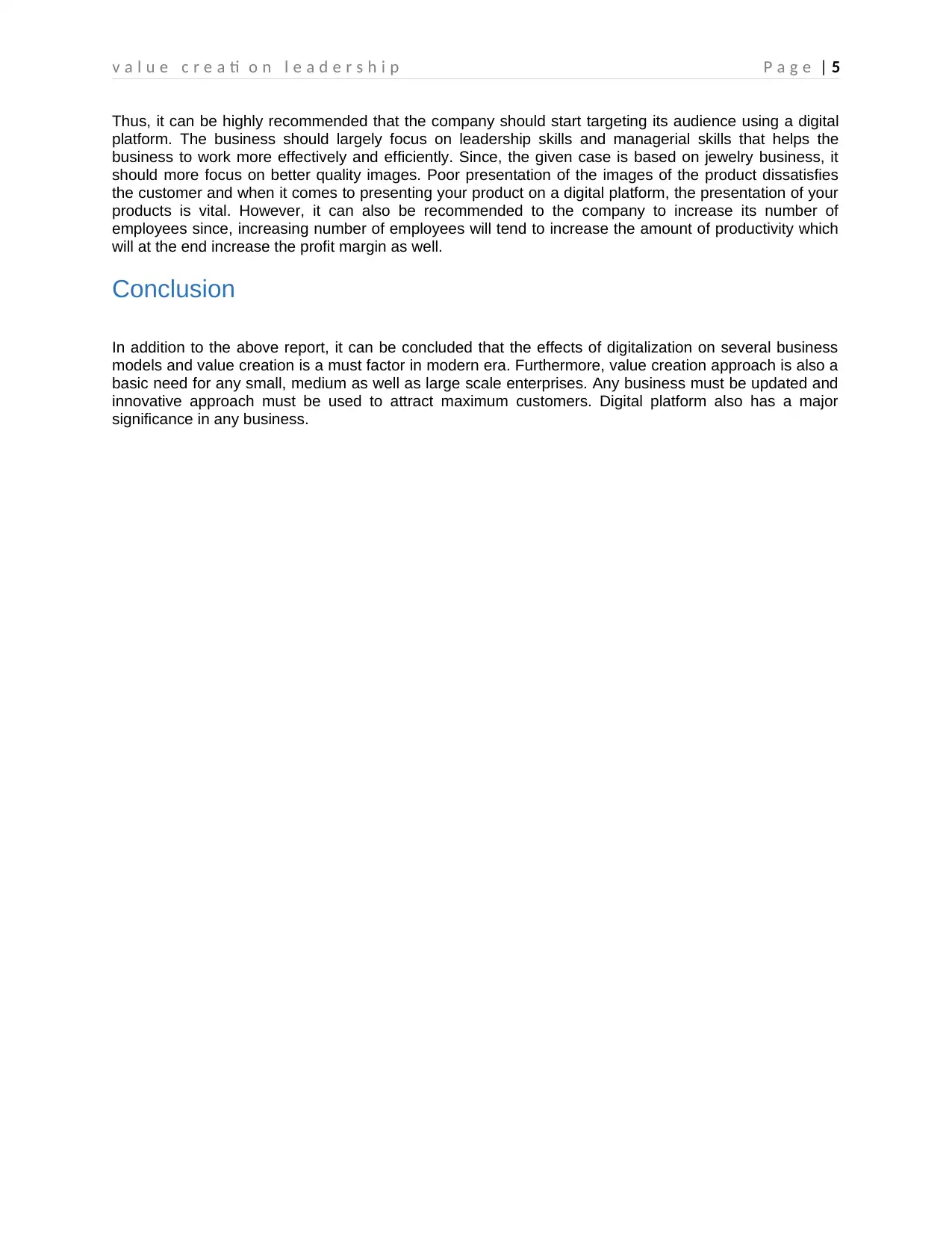
v a l u e c r e a ti o n l e a d e r s h i p P a g e | 5
Thus, it can be highly recommended that the company should start targeting its audience using a digital
platform. The business should largely focus on leadership skills and managerial skills that helps the
business to work more effectively and efficiently. Since, the given case is based on jewelry business, it
should more focus on better quality images. Poor presentation of the images of the product dissatisfies
the customer and when it comes to presenting your product on a digital platform, the presentation of your
products is vital. However, it can also be recommended to the company to increase its number of
employees since, increasing number of employees will tend to increase the amount of productivity which
will at the end increase the profit margin as well.
Conclusion
In addition to the above report, it can be concluded that the effects of digitalization on several business
models and value creation is a must factor in modern era. Furthermore, value creation approach is also a
basic need for any small, medium as well as large scale enterprises. Any business must be updated and
innovative approach must be used to attract maximum customers. Digital platform also has a major
significance in any business.
Thus, it can be highly recommended that the company should start targeting its audience using a digital
platform. The business should largely focus on leadership skills and managerial skills that helps the
business to work more effectively and efficiently. Since, the given case is based on jewelry business, it
should more focus on better quality images. Poor presentation of the images of the product dissatisfies
the customer and when it comes to presenting your product on a digital platform, the presentation of your
products is vital. However, it can also be recommended to the company to increase its number of
employees since, increasing number of employees will tend to increase the amount of productivity which
will at the end increase the profit margin as well.
Conclusion
In addition to the above report, it can be concluded that the effects of digitalization on several business
models and value creation is a must factor in modern era. Furthermore, value creation approach is also a
basic need for any small, medium as well as large scale enterprises. Any business must be updated and
innovative approach must be used to attract maximum customers. Digital platform also has a major
significance in any business.
⊘ This is a preview!⊘
Do you want full access?
Subscribe today to unlock all pages.

Trusted by 1+ million students worldwide
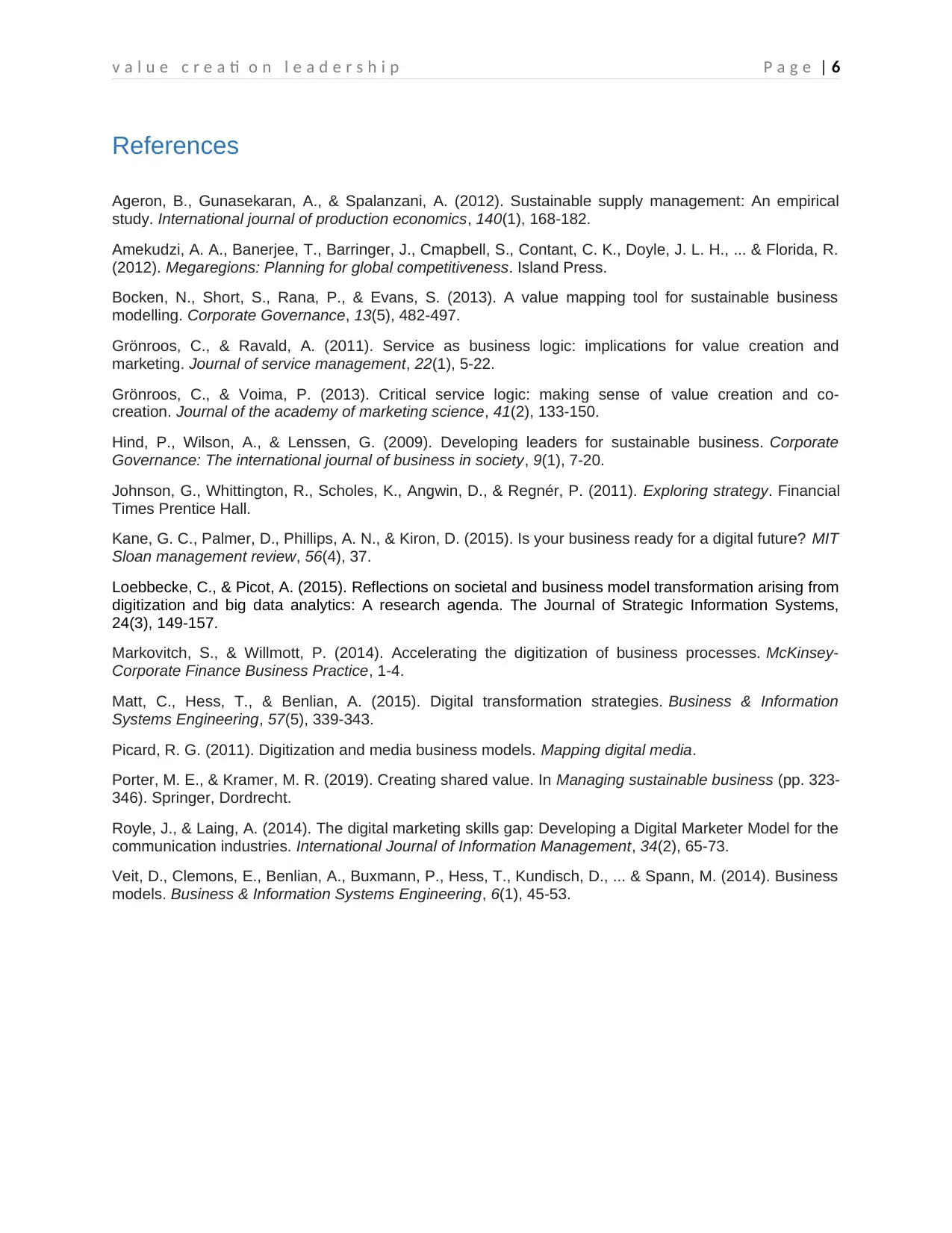
v a l u e c r e a ti o n l e a d e r s h i p P a g e | 6
References
Ageron, B., Gunasekaran, A., & Spalanzani, A. (2012). Sustainable supply management: An empirical
study. International journal of production economics, 140(1), 168-182.
Amekudzi, A. A., Banerjee, T., Barringer, J., Cmapbell, S., Contant, C. K., Doyle, J. L. H., ... & Florida, R.
(2012). Megaregions: Planning for global competitiveness. Island Press.
Bocken, N., Short, S., Rana, P., & Evans, S. (2013). A value mapping tool for sustainable business
modelling. Corporate Governance, 13(5), 482-497.
Grönroos, C., & Ravald, A. (2011). Service as business logic: implications for value creation and
marketing. Journal of service management, 22(1), 5-22.
Grönroos, C., & Voima, P. (2013). Critical service logic: making sense of value creation and co-
creation. Journal of the academy of marketing science, 41(2), 133-150.
Hind, P., Wilson, A., & Lenssen, G. (2009). Developing leaders for sustainable business. Corporate
Governance: The international journal of business in society, 9(1), 7-20.
Johnson, G., Whittington, R., Scholes, K., Angwin, D., & Regnér, P. (2011). Exploring strategy. Financial
Times Prentice Hall.
Kane, G. C., Palmer, D., Phillips, A. N., & Kiron, D. (2015). Is your business ready for a digital future? MIT
Sloan management review, 56(4), 37.
Loebbecke, C., & Picot, A. (2015). Reflections on societal and business model transformation arising from
digitization and big data analytics: A research agenda. The Journal of Strategic Information Systems,
24(3), 149-157.
Markovitch, S., & Willmott, P. (2014). Accelerating the digitization of business processes. McKinsey-
Corporate Finance Business Practice, 1-4.
Matt, C., Hess, T., & Benlian, A. (2015). Digital transformation strategies. Business & Information
Systems Engineering, 57(5), 339-343.
Picard, R. G. (2011). Digitization and media business models. Mapping digital media.
Porter, M. E., & Kramer, M. R. (2019). Creating shared value. In Managing sustainable business (pp. 323-
346). Springer, Dordrecht.
Royle, J., & Laing, A. (2014). The digital marketing skills gap: Developing a Digital Marketer Model for the
communication industries. International Journal of Information Management, 34(2), 65-73.
Veit, D., Clemons, E., Benlian, A., Buxmann, P., Hess, T., Kundisch, D., ... & Spann, M. (2014). Business
models. Business & Information Systems Engineering, 6(1), 45-53.
References
Ageron, B., Gunasekaran, A., & Spalanzani, A. (2012). Sustainable supply management: An empirical
study. International journal of production economics, 140(1), 168-182.
Amekudzi, A. A., Banerjee, T., Barringer, J., Cmapbell, S., Contant, C. K., Doyle, J. L. H., ... & Florida, R.
(2012). Megaregions: Planning for global competitiveness. Island Press.
Bocken, N., Short, S., Rana, P., & Evans, S. (2013). A value mapping tool for sustainable business
modelling. Corporate Governance, 13(5), 482-497.
Grönroos, C., & Ravald, A. (2011). Service as business logic: implications for value creation and
marketing. Journal of service management, 22(1), 5-22.
Grönroos, C., & Voima, P. (2013). Critical service logic: making sense of value creation and co-
creation. Journal of the academy of marketing science, 41(2), 133-150.
Hind, P., Wilson, A., & Lenssen, G. (2009). Developing leaders for sustainable business. Corporate
Governance: The international journal of business in society, 9(1), 7-20.
Johnson, G., Whittington, R., Scholes, K., Angwin, D., & Regnér, P. (2011). Exploring strategy. Financial
Times Prentice Hall.
Kane, G. C., Palmer, D., Phillips, A. N., & Kiron, D. (2015). Is your business ready for a digital future? MIT
Sloan management review, 56(4), 37.
Loebbecke, C., & Picot, A. (2015). Reflections on societal and business model transformation arising from
digitization and big data analytics: A research agenda. The Journal of Strategic Information Systems,
24(3), 149-157.
Markovitch, S., & Willmott, P. (2014). Accelerating the digitization of business processes. McKinsey-
Corporate Finance Business Practice, 1-4.
Matt, C., Hess, T., & Benlian, A. (2015). Digital transformation strategies. Business & Information
Systems Engineering, 57(5), 339-343.
Picard, R. G. (2011). Digitization and media business models. Mapping digital media.
Porter, M. E., & Kramer, M. R. (2019). Creating shared value. In Managing sustainable business (pp. 323-
346). Springer, Dordrecht.
Royle, J., & Laing, A. (2014). The digital marketing skills gap: Developing a Digital Marketer Model for the
communication industries. International Journal of Information Management, 34(2), 65-73.
Veit, D., Clemons, E., Benlian, A., Buxmann, P., Hess, T., Kundisch, D., ... & Spann, M. (2014). Business
models. Business & Information Systems Engineering, 6(1), 45-53.
1 out of 7
Related Documents
Your All-in-One AI-Powered Toolkit for Academic Success.
+13062052269
info@desklib.com
Available 24*7 on WhatsApp / Email
![[object Object]](/_next/static/media/star-bottom.7253800d.svg)
Unlock your academic potential
© 2024 | Zucol Services PVT LTD | All rights reserved.





